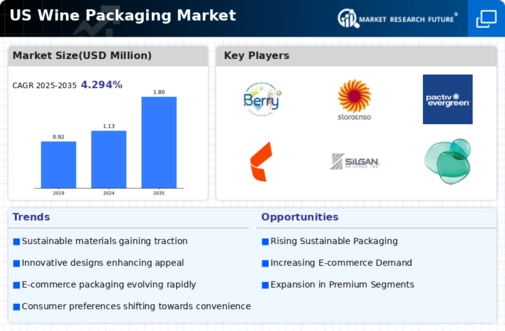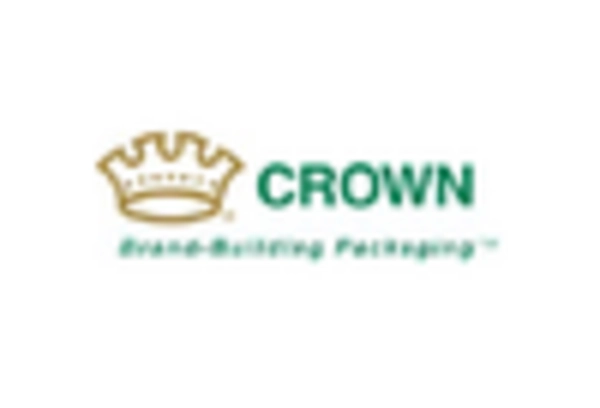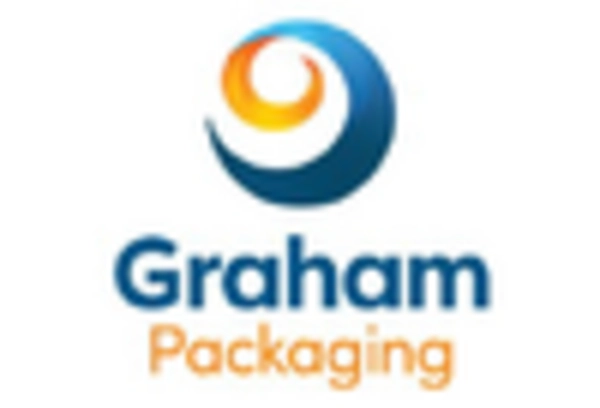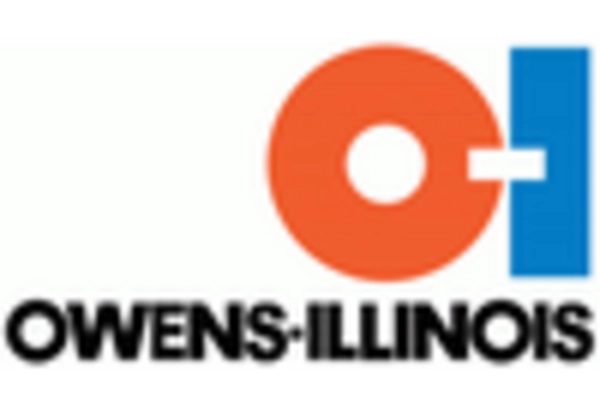Growing Demand for Eco-Friendly Packaging
The increasing consumer preference for environmentally friendly products is driving the wine packaging market. As awareness of sustainability issues rises, consumers are gravitating towards brands that utilize eco-conscious materials. In 2025, it is estimated that around 60% of consumers in the US are willing to pay a premium for sustainable packaging. This shift is prompting wine producers to adopt biodegradable and recyclable materials, thereby enhancing their market appeal. The wine packaging market is witnessing a transformation as companies innovate to meet these demands, potentially leading to a 15% growth in eco-friendly packaging solutions over the next few years. This trend not only aligns with consumer values but also helps brands differentiate themselves in a competitive landscape.
Consumer Preferences for Premium Packaging
The wine packaging market is experiencing a shift towards premium packaging options as consumers increasingly seek high-quality products. In 2025, it is estimated that around 40% of wine consumers in the US prefer premium packaging, which often includes glass bottles with intricate designs and high-end closures. This trend is driven by the perception that premium packaging enhances the overall wine experience. As a result, wine producers are investing in sophisticated packaging designs that reflect the quality of their products. This focus on aesthetics and quality in packaging is likely to contribute to a 12% growth in the premium segment of the wine packaging market, as brands strive to attract discerning consumers.
Regulatory Compliance and Safety Standards
The wine packaging market is influenced by stringent regulatory requirements aimed at ensuring consumer safety. In the US, the Alcohol and Tobacco Tax and Trade Bureau (TTB) enforces regulations that dictate labeling and packaging standards. Compliance with these regulations is essential for market players, as non-compliance can lead to costly penalties and product recalls. As regulations evolve, wine producers must adapt their packaging strategies to meet these standards, which may involve investing in new materials and technologies. This focus on compliance not only safeguards consumer health but also enhances brand reputation, potentially leading to a 10% increase in market growth as companies prioritize safety in their packaging solutions.
E-commerce Growth and Direct-to-Consumer Sales
The rise of e-commerce is reshaping the wine packaging market, as more consumers opt for online purchases. In 2025, online wine sales are projected to account for approximately 25% of total wine sales in the US. This shift necessitates packaging that ensures product safety during transit while also appealing to consumers visually. As a result, wine producers are investing in innovative packaging solutions that enhance the unboxing experience. The demand for lightweight, durable, and aesthetically pleasing packaging is likely to increase, driving growth in the wine packaging market. Companies that adapt to these e-commerce trends may see a significant boost in sales and customer loyalty.
Technological Advancements in Packaging Solutions
Technological innovations are playing a crucial role in the evolution of the wine packaging market. Advances in materials science and packaging technology are enabling the development of lighter, more durable, and sustainable packaging options. In 2025, it is anticipated that smart packaging solutions, such as QR codes and NFC technology, will become more prevalent, allowing consumers to engage with brands in new ways. These technologies not only enhance the consumer experience but also provide valuable data to producers regarding consumer preferences. As the wine packaging market embraces these advancements, it could see a growth rate of 8% as companies leverage technology to improve packaging efficiency and consumer engagement.

















Leave a Comment